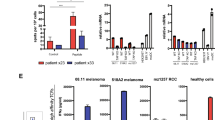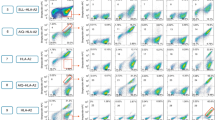Abstract
It is becoming increasingly apparent that the majority of tumours display defects in the MHC class I antigen processing pathway, particularly low levels of the transporters-associated with antigen processing (TAP) and tapasin. Thus, immunotherapy approaches targeting such tumours with CD8+ cytotoxic T lymphocytes (CTL) requires strategies to overcome these defects. Previously we had identified an antigen processing pathway by which cytosolically derived hydrophobic peptides could be presented in the absence of TAP. Here we show in the tapasin-negative cell line 721.220 that a number of these hydrophobic TAP-independent peptides can also be presented in a tapasin-independent manner. Yet when these experiments were extended to tumour cell lines derived from small cell lung cancer (SCLC), which we show to be tapasin deficient in addition to TAP-negative, the TAP-, tapasin-independent peptides were not presented. This lack of presentation could be rectified by pre-treatment of SCLC cells with IFNγ. Alternatively, by directing the TAP-, tapasin-independent peptides into the endoplasmic reticulum (ER) via an ER signal sequence, these peptides were presented efficiently by SCLC cells. We infer from this data that the TAP-independent pathway for presentation of hydrophobic peptides generates a low concentration of peptide in the ER and, for tumour cells which also lack tapasin, this concentration of antigenic peptide is insufficient to load onto MHC class I molecules. Thus, for immunotherapeutic approaches to target SCLC and other tumours with defects in the MHC class I antigen processing pathway it will be important to consider strategies that address tapasin-defects.





Similar content being viewed by others
Abbreviations
- ER:
-
Endoplasmic reticulum
- EBV:
-
Epstein-Barr virus
- CTL:
-
Cytotoxic T lymphocyte
- PLC:
-
Peptide loading complex
- SCLC:
-
Small cell lung cancer
- TAP:
-
Transporters associated with antigen processing
References
Abril E, Mendez RE, Garcia A, Serrano A, Cabrera T, Garrido F, Ruiz-Cabello F (1996) Characterization of a gastric tumor cell line defective in MHC class I inducibility by both alpha- and gamma-interferon. Tissue Antigens 47:391–398
Alimonti J, Zhang QJ, Gabathuler R, Reid G, Chen SS, Jefferies WA (2000) TAP expression provides a general method for improving the recognition of malignant cells in vivo. Nat Biotechnol 18:515–520
Anton LC, Yewdell JW, Bennink JR (1997) MHC class I-associated peptides produced from endogenous gene products with vastly different efficiencies. J Immunol 158:2535–2542
Atkins D, Ferrone S, Schmahl GE, Storkel S, Seliger B (2004) Down-regulation of HLA class I antigen processing molecules: an immune escape mechanism of renal cell carcinoma. J Urol 171:885–889
Barber LD, Howarth M, Bowness P, Elliott T (2001) The quantity of naturally processed peptides stably bound by HLA-A*0201 is significantly reduced in the absence of tapasin. Tissue Antigens 58:363–368
Coulson JM, Stanley J, Woll PJ (1999) Tumour-specific arginine vasopressin promoter activation in small- cell lung cancer. Br J Cancer 80:1935–1944
Coulson JM, Edgson JL, Woll PJ, Quinn JP (2000) A splice variant of the neuron-restrictive silencer factor repressor is expressed in small cell lung cancer: a potential role in derepression of neuroendocrine genes and a useful clinical marker. Cancer Res 60:1840–1844
Doyle A, Martin WJ, Funa K, Gazdar A, Carney D, Martin SE, Linnoila I, Cuttitta F, Mulshine J, Bunn P, Minna J (1985) Markedly decreased expression of class I histocompatibility antigens, proteins and mRNA in human small-cell lung cancer. J Exp Med 161:1135–1151
Facoetti A, Nano R, Zelini P, Morbini P, Benericettti E, Ceroni M, Campoli M, Ferrone S (2005) Human leukocyte antigen and antigen processing machinery component defects in astrocytic tumors. Clin Can Res 11:8304–8311
Gil-Torregrosa BC, Raul Castano A, Del Val M (1998) Major histocompatibility complex class I viral antigen processing in the secretory pathway defined by the trans-Golgi network protease furin. J Exp Med 188:1105–1116
Greenwood R, Shimizu Y, Sekhon GS, DeMars R (1994) Novel allele-specific, post-translational reduction in HLA class I surface expression in a mutant human B cell line. J Immunol 153:5525–5536
Henderson RA, Michel H, Sakaguchi K, Shabanowitz J, Appella E, Hunt DF, Engelhard VH (1992) HLA-A2.1-associated peptides from a mutant cell line: a second pathway of antigen presentation. Science 255:1264–1266
Hicklin DJ, Marincola FM, Ferrone S (1999) HLA class I antigen downregulation in human cancers: T cell immunotherapy revives an old story. Mol Med Today 5:178–186
Khanna R. (1998) Tumour surveillance: missing peptides and MHC molecules. Immunol Cell Biol 76:20–26
Lautscham G, Mayrhofer S, Taylor G, Haigh T, Leese A, Rickinson A, Blake N (2001) Processing of a multiple membrane spanning Epstein-Barr virus protein for CD8+ T cell recognition reveals a proteasome-dependent, transporter associated with antigen processing-independent pathway. J Exp Med 194:1053–1068
Lewis JW, Sewell A, Price D, Elliott T (1998) HLA-A*0201 presents TAP-independent peptide epitopes to cytotoxic T lymphocytes in the absence of tapasin. Eur J Immunol 28:3214–3220
Lopez-Albaitero A, Nayak JV, Ogino T, Machandia A, Gooding W, DeLeo AB, Ferrone S, Ferris RL (2006) Role of antigen-processing machinery in the in vitro resistance of squamous cell carcinoma of the head and neck cells to recognition by CTL. J Immunol 176:3402–3409
Lou Y, Vitalis TZ, Basha G, Cai B, Chen SS, Choi KB, Jeffries AP, Elliot WM, Atkins D, Seliger B, Jefferies WA (2005) Restoration of the expression of transporters associated with antigen processing in lung carcinoma increases tumor-specific responses and survival. Cancer Res 65:7926–7933
Morris EC, Bendle GM, Stuass HJ (2003) Prospects for immunotherapy of malignant disease. Clin Exp Immunol 131:1–7
Ogino T, Bandoh N, Hayashi T, Miyokawa N, Harabuchi Y, Ferrone S (2003) Association of tapasin and HLA class I antigen down-regulation in primary maxillary sinus squamous cell carcinoma lesions with reduced survival of patients. Clin Can Res 9:4043–4051
Ortmann B, Copeman J, Lehner PJ, Sadasivan B, Herberg JA, Grandea AG, Riddell SR, Tampe R, Spies T, Trowsdale J, Cresswell P (1997) A critical role for tapasin in the assembly and function of multimeric MHC class I-TAP complexes. Science 277:1306–1309
Pamer E, Cresswell P (1998) Mechanisms of MHC class I-restricted antigen processing. Ann Rev Immunol 16:323–358
Peh CA, Burrows SR, Barnden M, Khannna R, Cresswell P, Moss DJ, McCluskey J (1998) HLA-B27-restricted antigen presentation in the absence of tapasin reveals polymorphism in mechanisms of HLA class I peptide loading. Immunity 8:531–542
Restifo NP, Esquivel F, Kawakami Y, Yewdell JW, Mule JJ, Rosenberg SA, Bennink JR (1993) Identification of human cancers deficient in antigen processing. J Exp Med 177:262–272
Salter RD, Cresswell P (1986) Impaired assembly and transport of HLA-A and -B antigens in a mutant TxB cell hybrid. EMBO J 5:943–949
Seliger B, Maeurer MJ, Ferrone S (2000) Antigen-processing machinery breakdown and tumor growth. Immunol Today 211:455–464
Seliger B, Schreiber K, Delp K, Meissner M, Hammers S, Reichert T, Pawlischko K, Tampe R, Huber C (2001) Downregulation of the constitutive tapasin expression in human tumor cells of distinct origin and it upregulation by cytokines. Tissue Antigens 57:39–45
Seliger B, Atkins D, Bock M, Ritz U, Ferrone S, Huber C, Storkel S (2003) Characterization of human lymphocyte antigen class I antigen-processing machinery defects in renal cell carcinoma lesions with special emphasis on transported-associated with antigen-processing down-regulation. Clin Cancer Res 9:1721–1727
Sherritt M, Cooper L, Moss DJ, Kienzle N, Altman J, Khanna R (2001) Immunization with tumor-associated epitopes fused to an endoplasmic reticulum translocation signal sequence affords protection against tumors with down-regulated expression of MHC and peptide transporters. Int Immunol 13:265–271
Singal DP, Ye M, Qiu X (1996) Molecular basis for lack of expression of HLA class I antigens in human small-cell lung carcinoma cell lines. Int J Cancer 68:629–636
Snyder HL, Bacik I, Bennink JR, Kearns G, Behrens TW, Bachi T, Orlowski M, Yewdell JW (1997) Two novel routes of transporter associated with antigen processing (TAP)-independent major histocompatibility complex class I antigen processing. J Exp Med 186:1087–1098
Spies T, Cerundolo V, Colonna M, Cresswell P, Townsend A, DeMars R (1992) Presentation of viral antigen by MHC class I is dependent on a putative peptide transporter heterodimer. Nature 355:644–646
Wolfel C, Drexler I, Van Pel A, Thres T, Leister N, Herr W, Sutter G, Huber C, Wolfel T (2000) Transporter (TAP)- and proteasome-independent presentation of a melanoma-associated tyrosinase epitope. Int J Cancer 88:432–438
Wong LH, Krauer KG, Hatzinisiriou I, Estcourt MJ, Hersey P, Tam ND, Edmondson S, Devenish RJ, Ralph SJ (1997) Interferon-resistant human melanoma cells are deficient in ISGF3 components, STAT1, STAT2, and p48-ISGF3γ. J Biol Chem 272:28779–28785
Acknowledgments
This work was supported by grants from North West Cancer Research Fund and Cancer Research UK. We thank the Department of Immunology (RLBUHT, Liverpool, UK) for HLA typing, and Drs A. Hislop (Birmingham, UK), T. Elliott (Southampton, UK) and P. Lehner (Cambridge, UK) for providing valuable reagents.
Author information
Authors and Affiliations
Corresponding author
Rights and permissions
About this article
Cite this article
Aladin, F., Lautscham, G., Humphries, E. et al. Targeting tumour cells with defects in the MHC Class I antigen processing pathway with CD8+ T cells specific for hydrophobic TAP- and Tapasin-independent peptides: the requirement for directed access into the ER. Cancer Immunol Immunother 56, 1143–1152 (2007). https://doi.org/10.1007/s00262-006-0263-2
Received:
Accepted:
Published:
Issue Date:
DOI: https://doi.org/10.1007/s00262-006-0263-2




